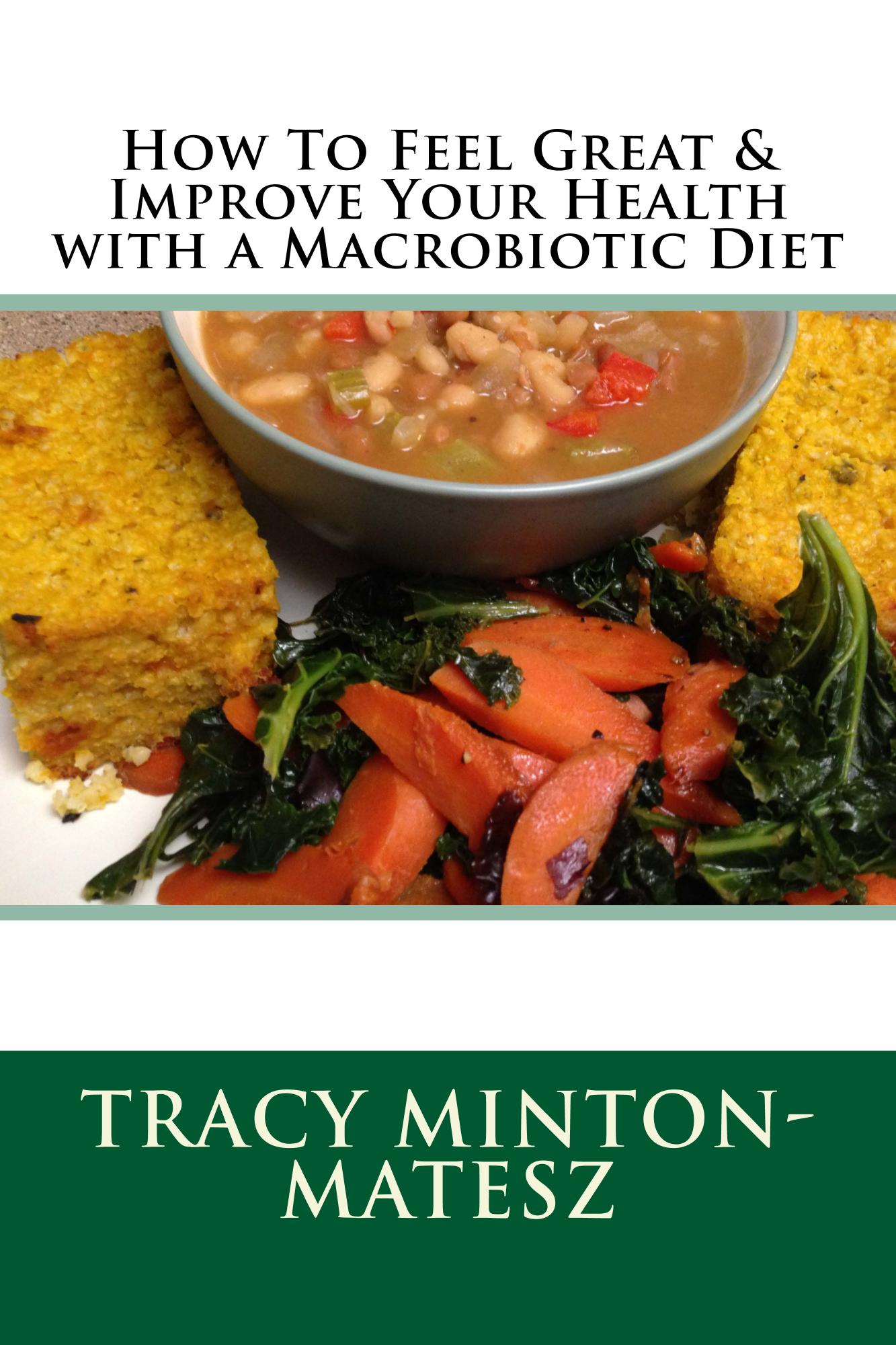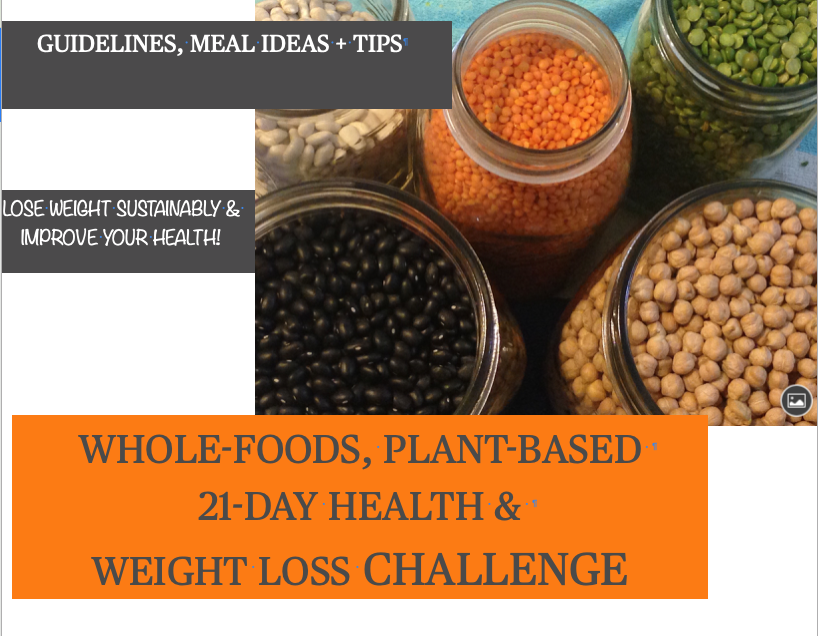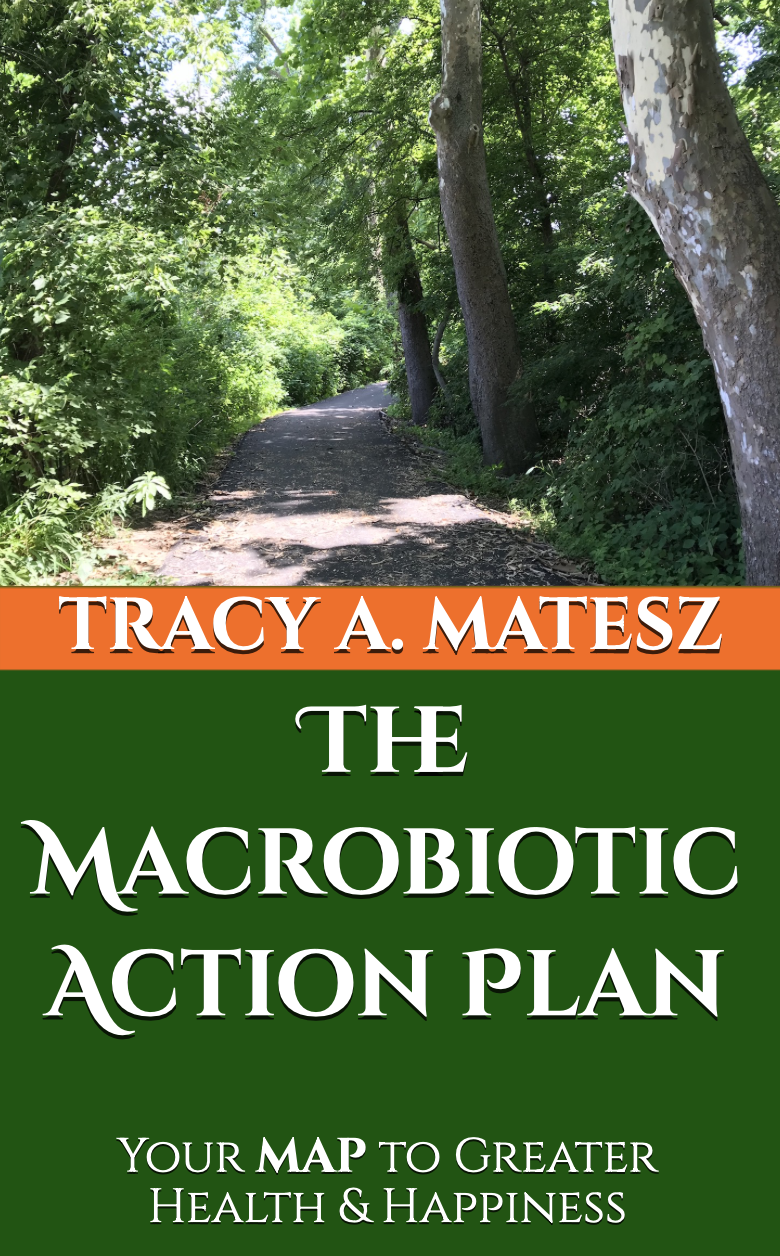Vegan Split Pea Soup
Vegan Split Pea Soup is a nutrient-rich bowl of comfort, high in protein, potassium, fiber, and many other nutrients. Split peas, beans and legumes in general, offer many health benefits, including increased satiety and appetite regulation, which supports better weight management. And that's just one of many impressive health benefits associated with regular consumption of split peas, and other pulses ~ beans, peas, chickpeas and lentils ~ briefly outlined, below.
Serve it up with some fresh baked vegan cornbread and a salad for a great summer meal. Or check out my Yellow Split Pea Soup recipe with sweet and earthy spices which add a nice bit of warmth to the soup, ideal during the cooler months.
A Few Health Benefits of Split Peas
Peas, lentils, beans and legumes, collectively called pulses, are a primary source of phytate in the diet, also found in cereal grains, nuts, and oilseeds. According to Pulse Consumption, Satiety and Weight Management, an abstract published in the National Library of Medicine, "Phytate has been shown to reduce the in vitro rate of starch digestion and delay postprandial glucose absorption in humans, which could contribute to satiety and delay the return of hunger..." (That translates to better appetite regulation and weight management!)
According to the American Institute of Cancer Research (AICR), there is 'probable' evidence that foods high in dietary fiber such as split peas, beans, and other legumes decrease the risk of colorectal cancer, weight gain and obesity. And, evidence indicates that, "excess body fat increases the risk of at least 12 different cancers." (Plus the high fiber foods contribute to satiety, as shown above, thereby aiding with weight loss, and reduced risk for many other diseases as well.)
Yellow split peas have been shown to posses high anti-oxidant and anti-bacterial activities, inhibiting production of nitric oxide. Other research has shown that peas and beans can help reduce blood pressure and lower cholesterol, respectively.
Aside from all the amazing health benefits of split peas and other beans and legumes, Split Pea Soup is a tasty and satisfying way to fuel your day ~ and help with appetite regulation and weight management!
Vegan Split Pea Soup Ingredient Notes
The Split Pea Soup recipe below is the foundation recipe to which I may add additional vegetables, condiments or seasonings ~ depending on what I have on hand.
You may want to see my top recommended condiments to have on hand for vegan macrobiotic cooking ~ especially for achieving a savory, salty or umami flavor ~ without using salt. Sodium in a fermented form poses far fewer health risks than when using traditional table salt or high sodium packaged foods. This is especially true for miso paste.
These are my suggestions, however, make do with what you have, and adjust according to your tastes.
If you prefer a thicker, creamier Vegan Split Pea Soup, I recommend using an immersion blender to purée the soup once cooked. Makes the job much easier then using a blender or food processor, with less clean-up.
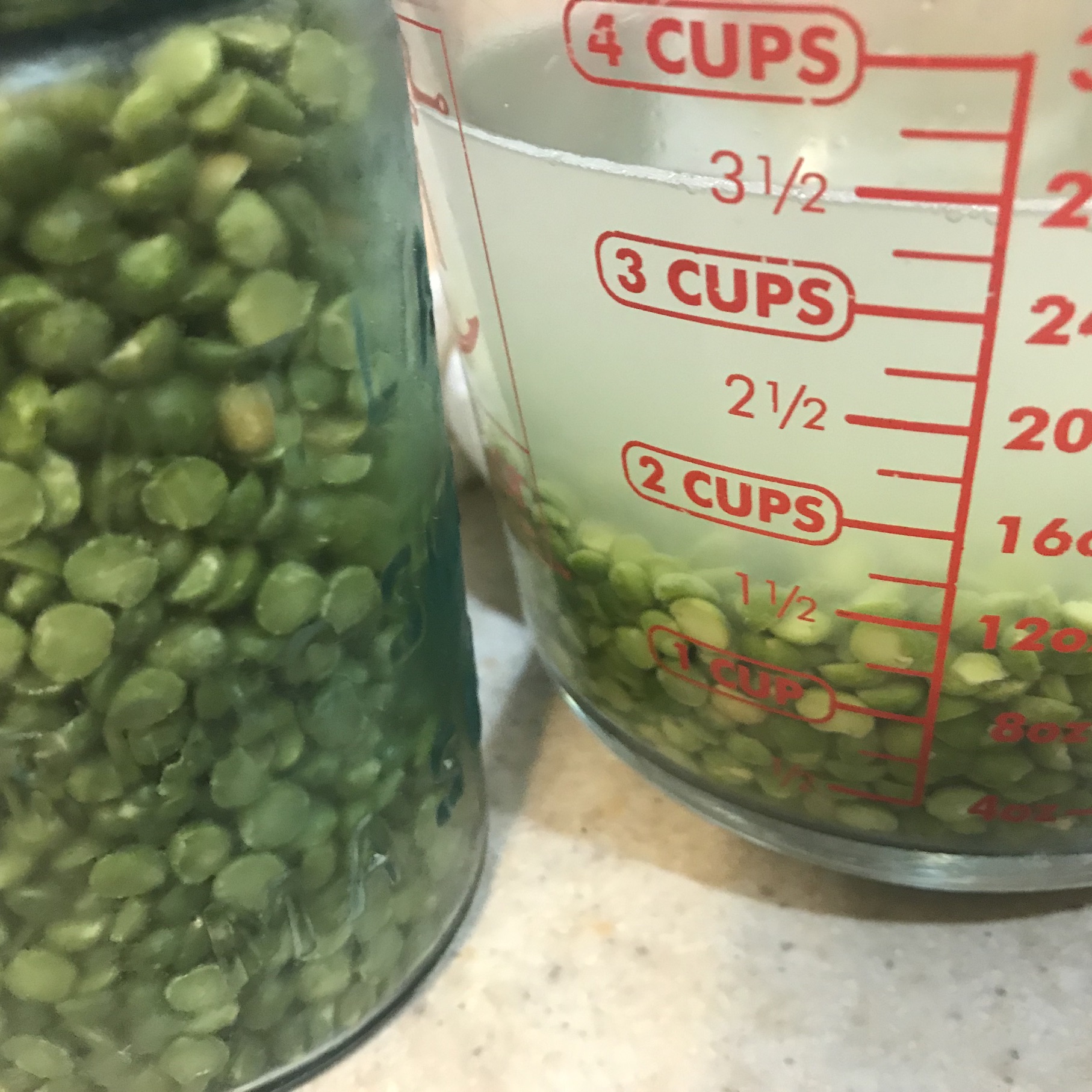
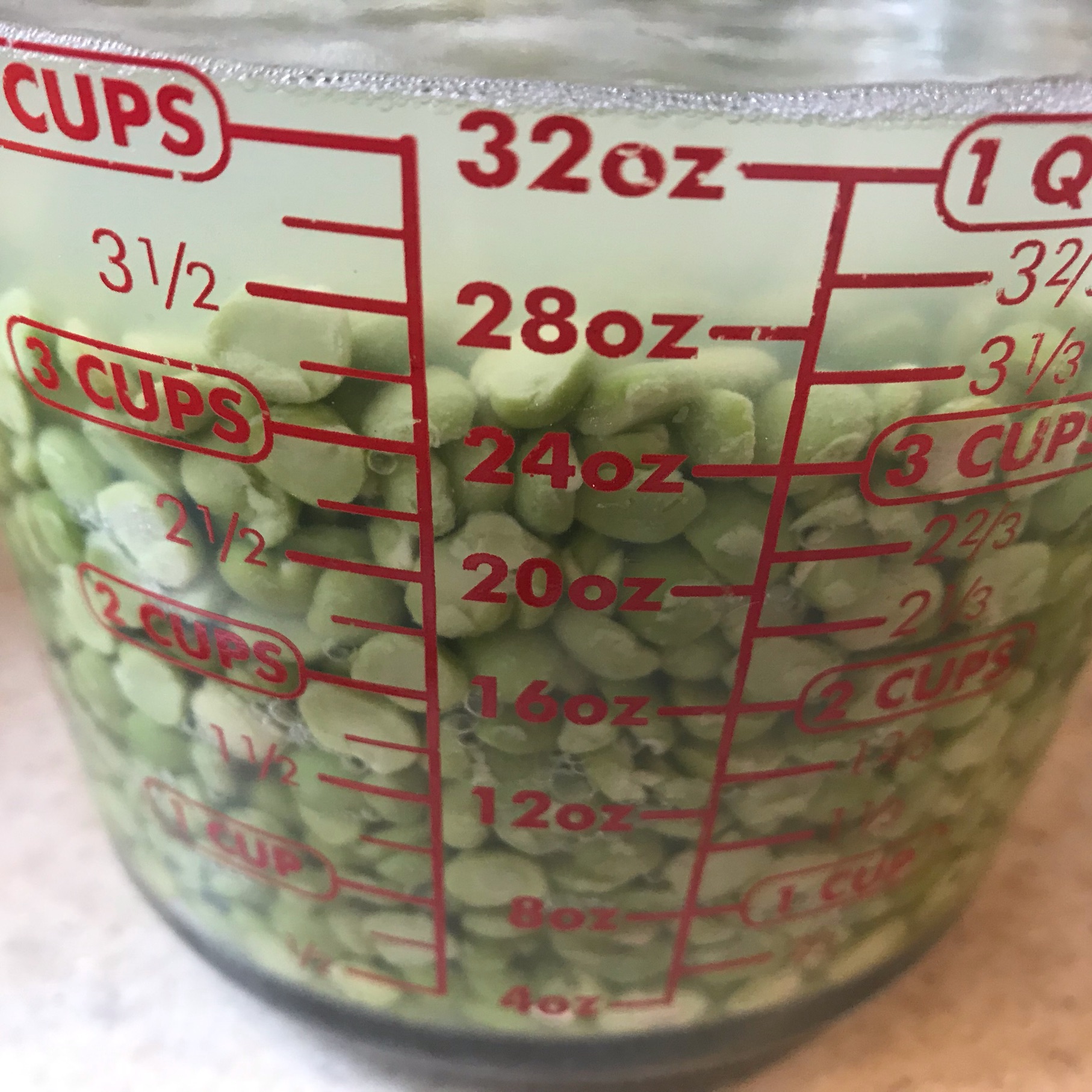
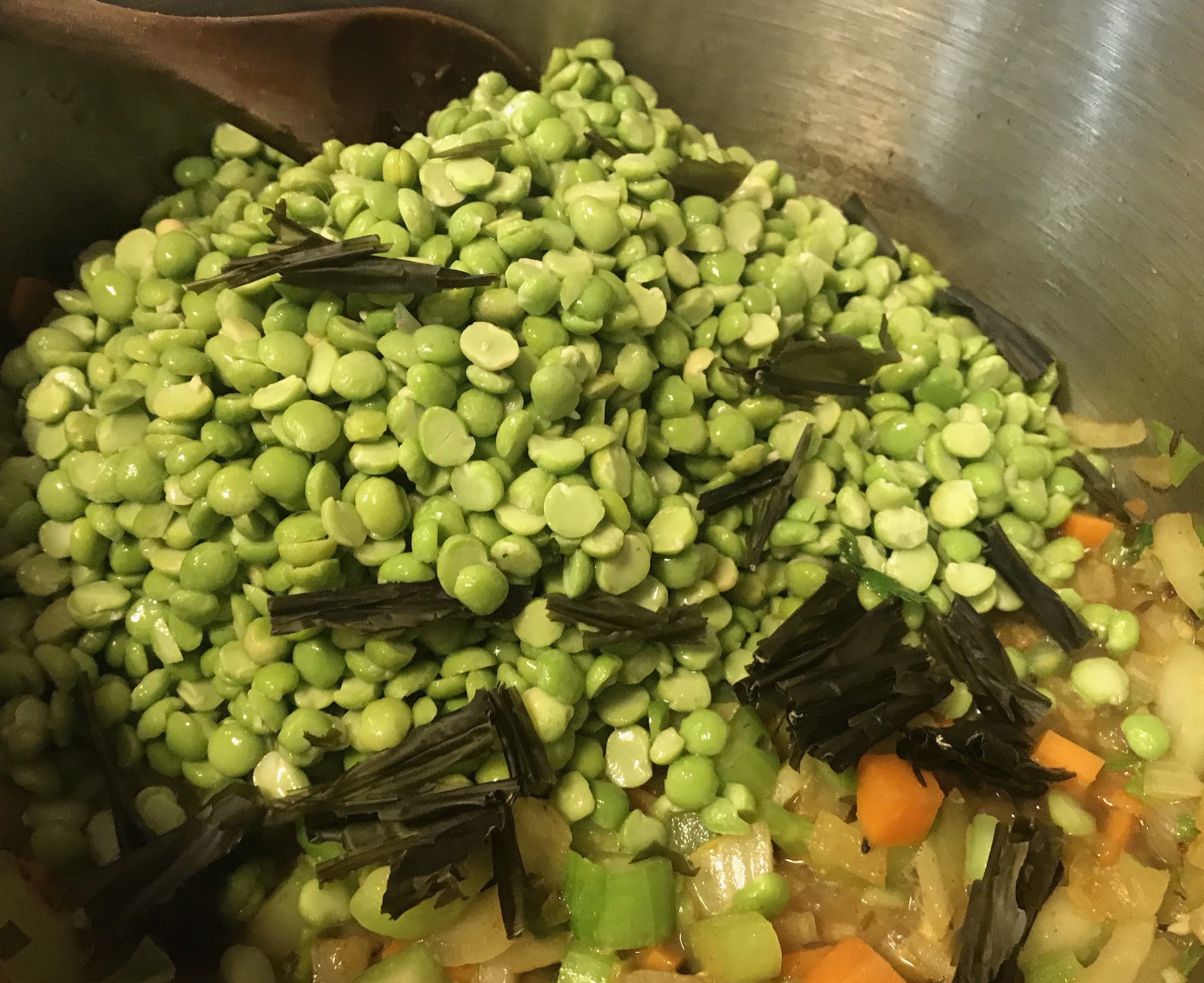
For my 'summer' Split Pea Soup, I like adding a lot of celery and carrot, which is pretty standard in most soup recipes. What many people may not know is how beneficial celery can be ~ in addition to helping flavor the soup.
According to The Tao of Nutrition, by Maoshing Ni, Ph.D., celery has a cool nature, and slightly sweet and bitter taste. It promotes diuresis, meaning it's great for leaching out dampness, or excess water retention ~ especially helpful when it’s hot and humid outside. (If you have a hard time taking your rings off at the end of a hot, humid summer day, or your ankles are swollen, eat more celery!)
There is another cooling summer vegetable not typically found in Split Pea Soup recipes that is a great albeit optional addition: Cucumber!
I recently discovered this by accident. This summer, I made my first Cucumber Soup which was really good. Since cucumbers are at peak harvest, I decided to add some to this recipe and really liked it!
If you like having some slightly crunchy vegetables in your soup ~ and you happen to have an abundance of cucumbers around ~ give it a try! I think you'll really enjoy it ~ but it’s purely optional.
You can also add chopped fresh or already quick blanched (QB) greens like kale or collards.
Potato or even sweet potato helps thicken the soup. In lieu of potato, leftover cooked brown rice, or (uncooked) oats can be used instead.
Other summer harvest veggies that are a nice complement to Split Pea Soup ~ whether cooked into the soup, or served on top as a garnish ~ include: fresh raw or roasted red peppers, diced Roma tomatoes, sliced scallion, or chopped fresh herbs like cilantro, parsley or chives.
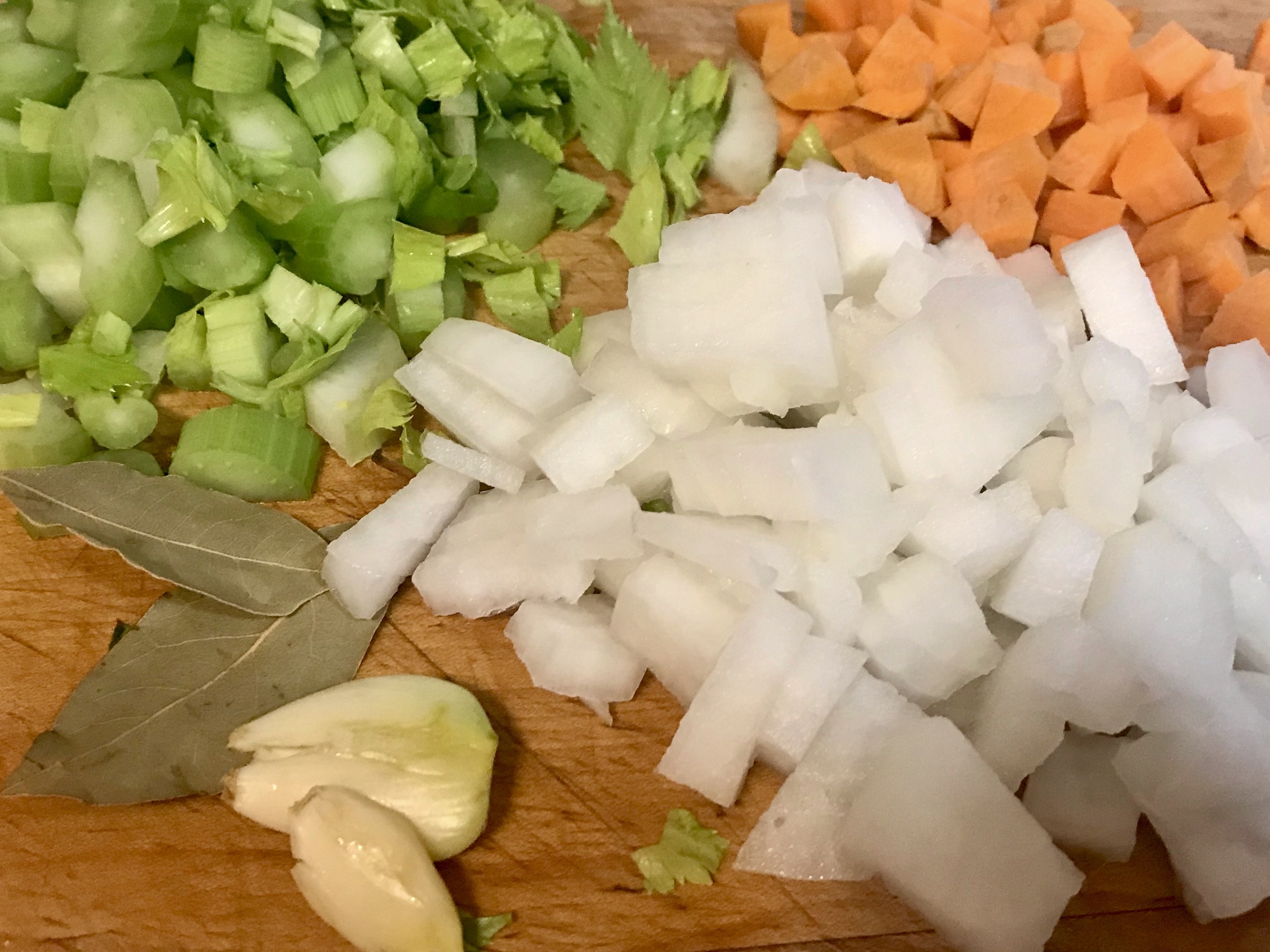
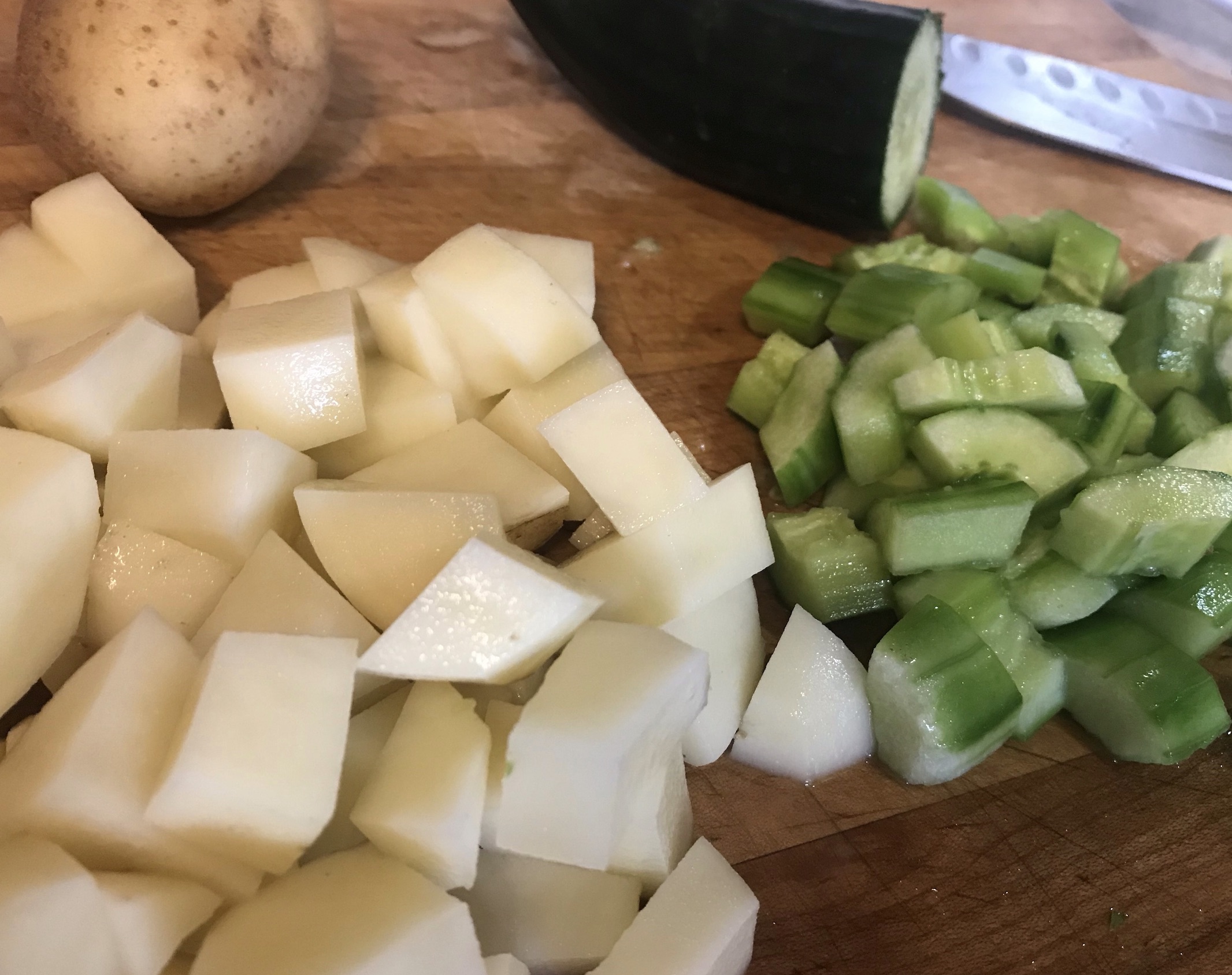
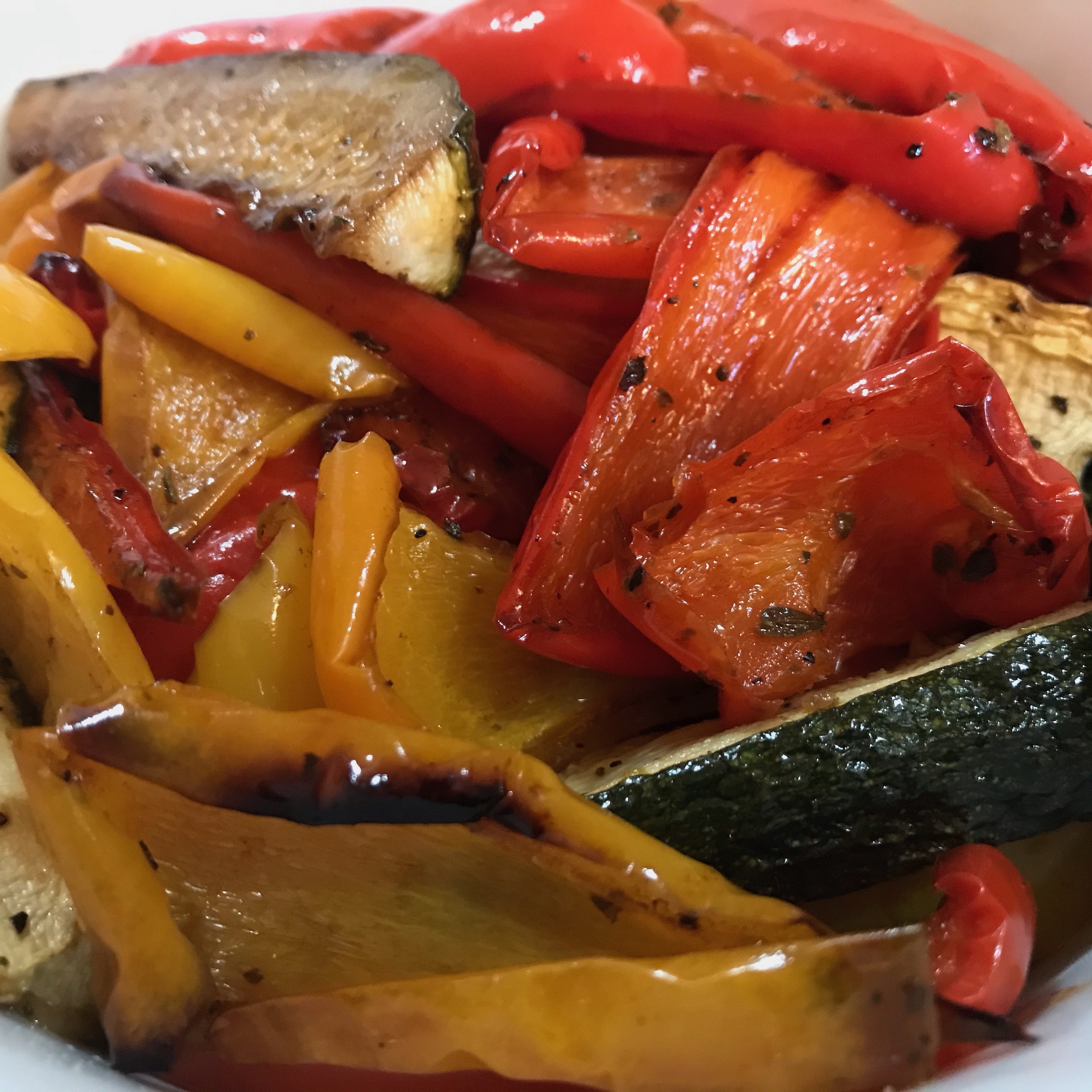
Roasted Red Peppers Or Summer Vegetable Medley
A colorful roasted pepper medley makes an especially striking garnish for the otherwise mostly green colored Split Pea Soup.
So...
If you like roasted peppers ~ possibly along with roasted tomatoes, zucchini, sweet onions and/or eggplant ~ you may want to prepare a big batch to have on hand. They are great added to salads, soups, pasta, or as a stand alone side vegetable.
To Roast Peppers (alone or with zucchini and onion):
Toss chopped bell or sweet peppers with balsamic vinegar, Italian herbs, rosemary, pepper, and optional olive oil, and roast for about 30-35 minutes at 375-380º, or until veggies are soft, and the peppers are just starting to char.
Garnish Split Pea Soup with a couple spoonfuls of the roasted pepper medley before serving, or add to a pasta salad to enjoy along side your Vegan Split Pea Soup. Save the rest to enjoy at another meal.
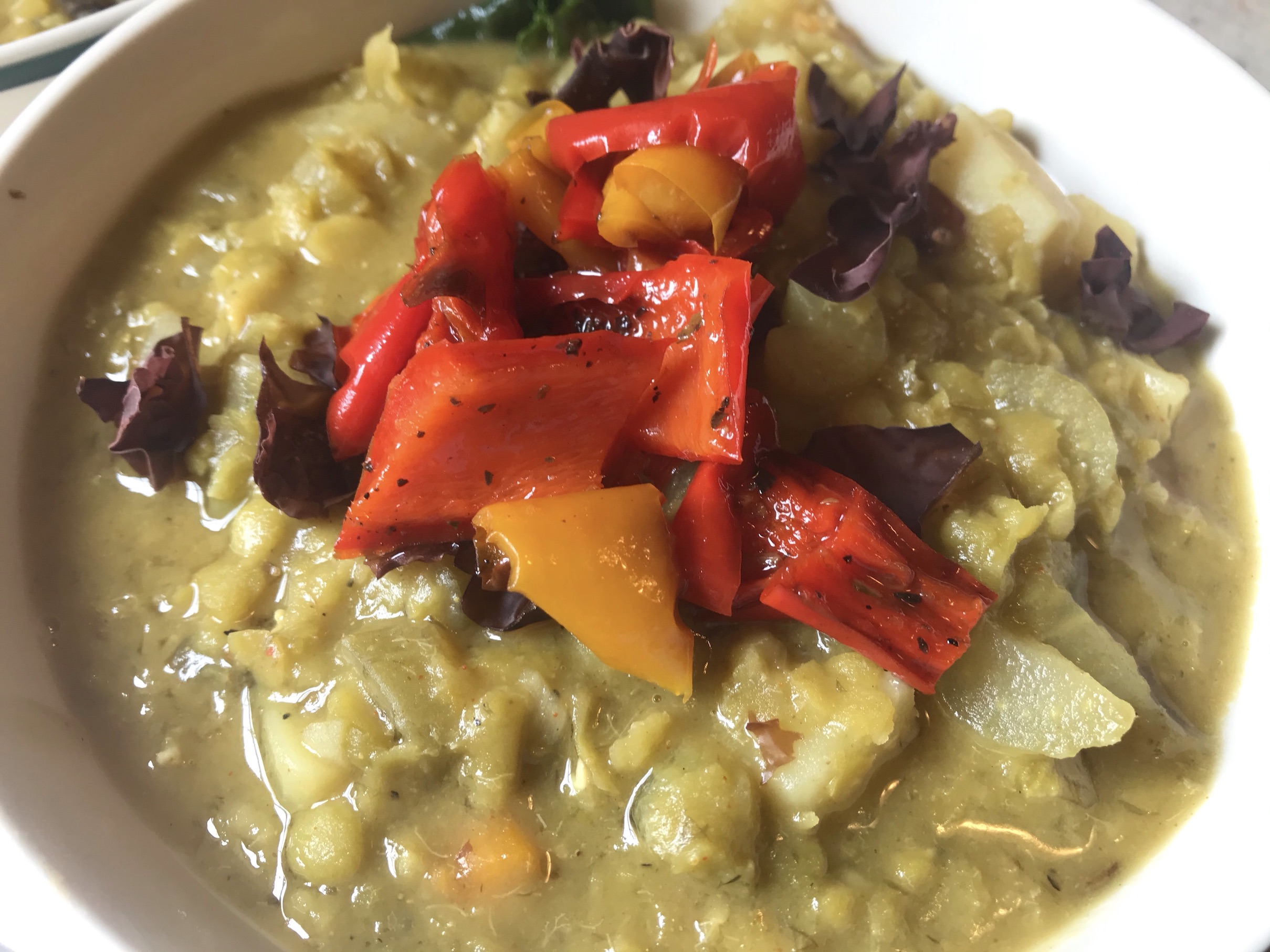 |
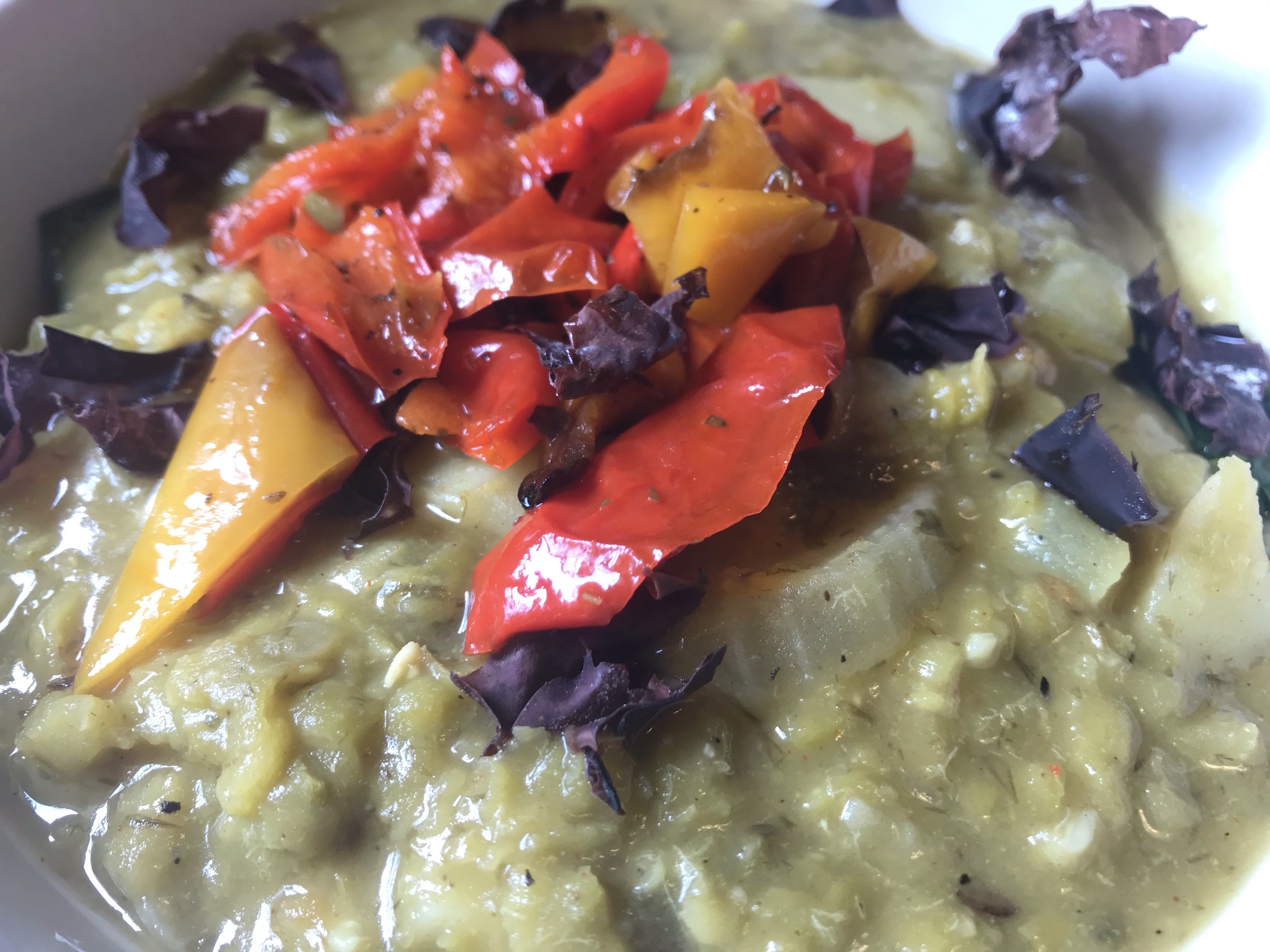 |
Special Ingredients for a Savory / Smoky Vegan Split Pea Soup
Here are the special condiments I used to add a savory and slightly smoky flavor to the Vegan Split Pea Soup. Click here for more details.
- I used Dulse, a delicate, red seaweed that can be used as is, or lightly toasted, and has a flavor somewhat similar to smoked salmon, or like bacon when crisped up first. Dulse can be added to other bean soups, vegetable dishes, stir fries, or salads, or even on a sandwich.
- Smoked Paprika & Liquid Smoke also add a smoky flavor to vegan soups and stews.
- Vegan Worcestershire Sauce
- San-J Reduced Sodium Tamari Lite
- Miso Masters
A note about all the resources: I've included links to those products I use, or trust to be of a better quality and value. I link them for those who may be less familiar, to see what the product looks like, and for convenience for those ordering online. Some of these may also be found at your local natural foods store, Whole Foods, or online for a better price at Vitacost.com. Any purchases made through the above links do provide a small commission for me, which helps support my time to continue making more informative content available, and is greatly appreciated!
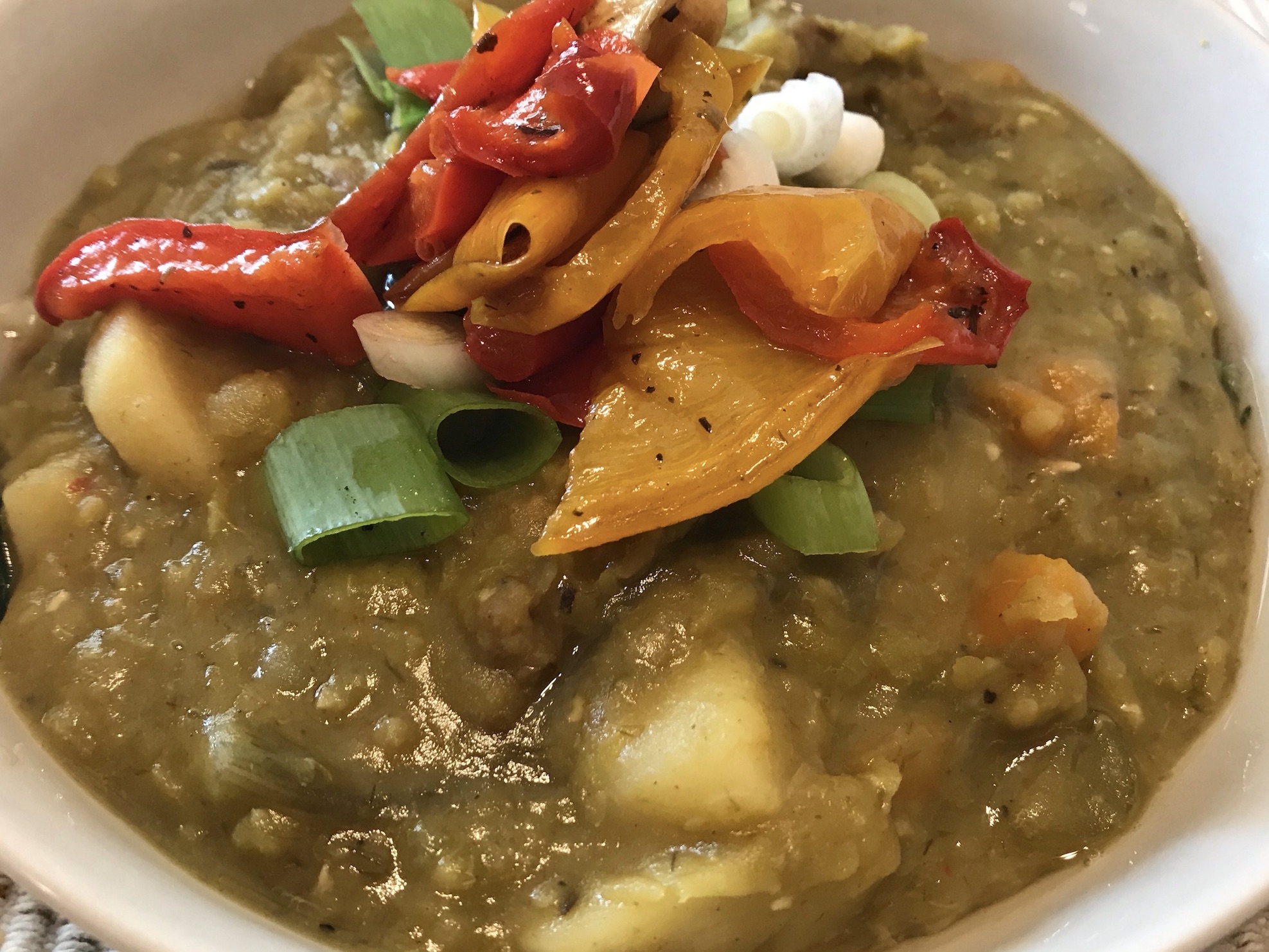 |
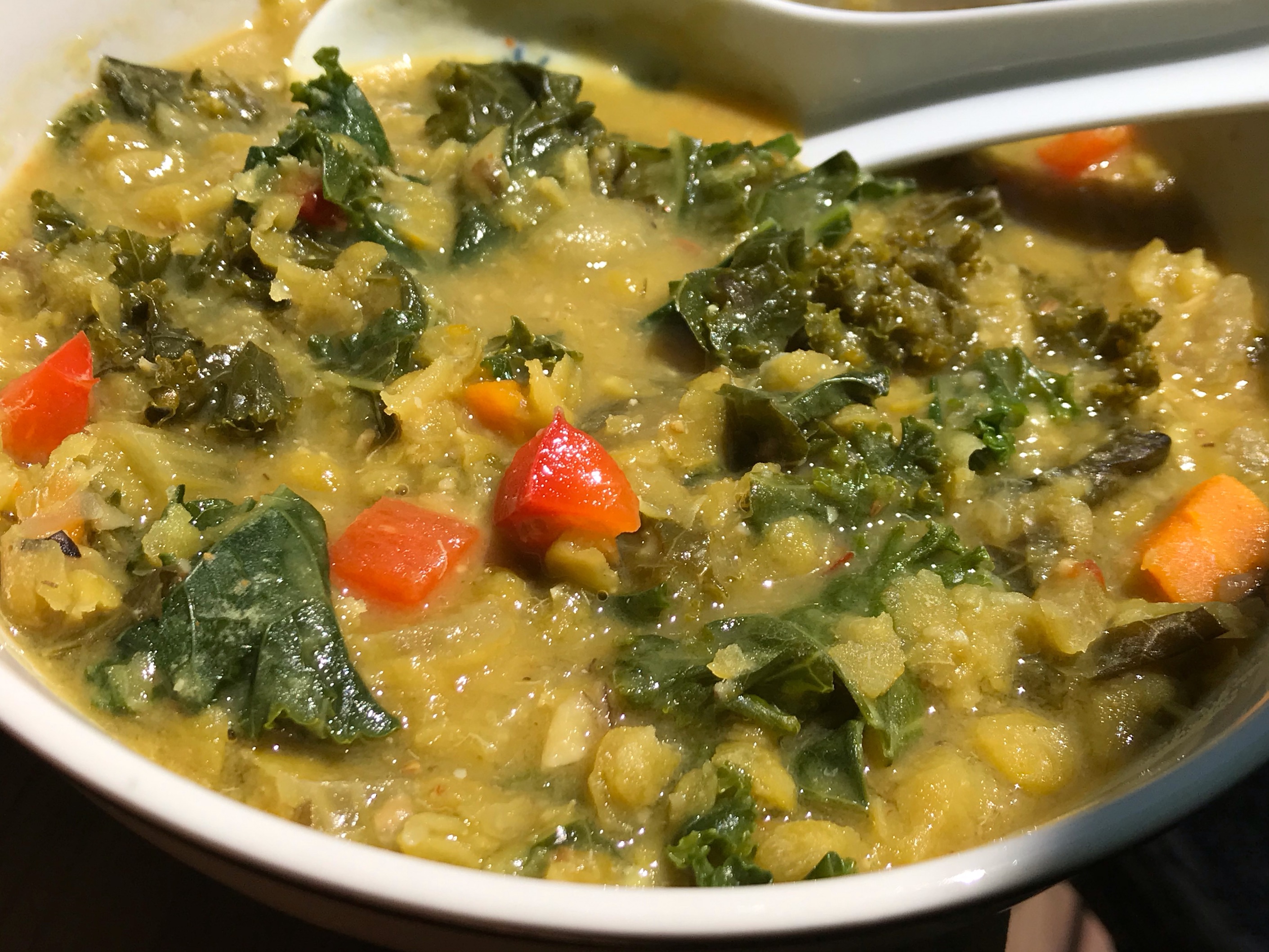 |
As you can see from the above photo of the split peas, 1&1/2 cups of split peas doubles in volume after soaking peas overnight.
When able, I highly suggest soaking beans for greater digestibility. That said, you can skip this step if need be.
I usually cook the split peas in water, however, if I happen to have some broth remaining from cooking other beans, or even some pasta cooking water, I'll use that as well.
Pasta cooking water can be saved in a jar in the fridge. We use it for cooking porridge or soups as it adds a little extra creaminess. Otherwise we pour it on the garden plants.
Vegan Split Pea Soup Ingredients & Steps
Ingredients
- 1&1/2 cups split peas
- ~(About) 4-6 cups of water (enough to cover by 1-2 inches)
- 2 tsp. cooking oil (see my suggestions, here; to omit, see note following the recipe)
- 1 small sweet onion, diced
- 2 stalks celery, chopped
- 1 large carrot, chopped
- 1-2 cloves garlic, peeled & minced or crushed
- 1 tsp. cumin seeds + 1 tsp. ground cumin (or use all ground)
- 1 tsp. sweet yellow curry or turmeric
- 1 4 inch (+/-) piece of kelp/kombu seaweed
- 1-2 bay leaves
- 2 -3 small - medium sized Yukon gold, or local white potatoes, or sub with 1 medium sweet potato
- 1/2 cucumber, peeled, seeded & diced (optional)
- Kale or collard greens, chopped, or previously quick blanched, optional
- Black pepper, lemon pepper, or other peppery salt-free seasoning you like, &/or use a couple pinches of red chili powder
- 1 tsp. (vegan) Worcestershire sauce
- Several drops of liquid smoke, optional
- 1-2 tsp. low-sodium tamari, OR 1/2-1 tsp. miso paste (white, barley, or red miso) per serving
- Squeeze of lemon, (or smidge of sherry) optional
- Possible garnishes: fresh diced sweet or red bell pepper or roasted peppers, chopped cilantro, parsley or chives, chopped arugula, or sliced scallion as outlined above
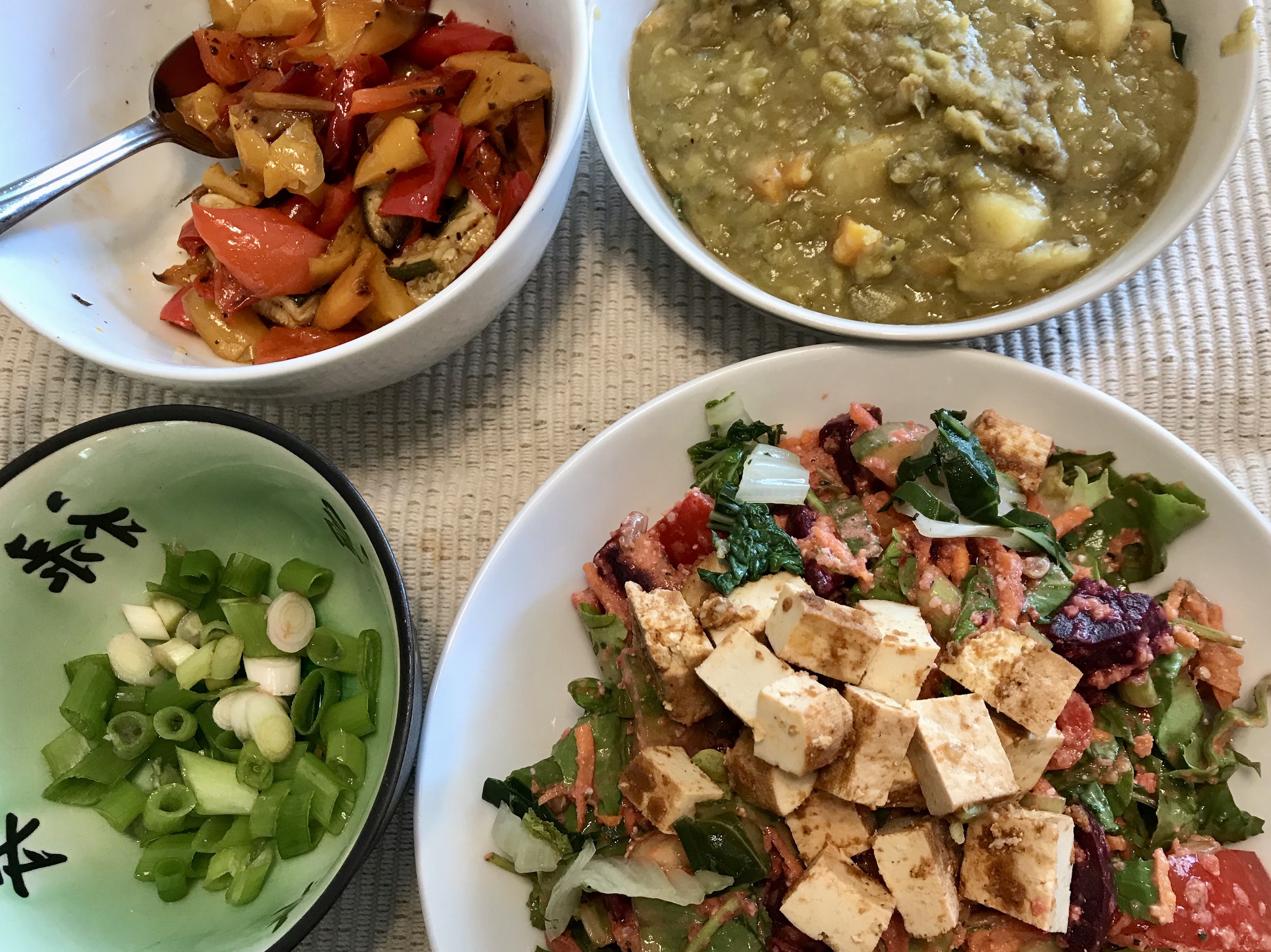
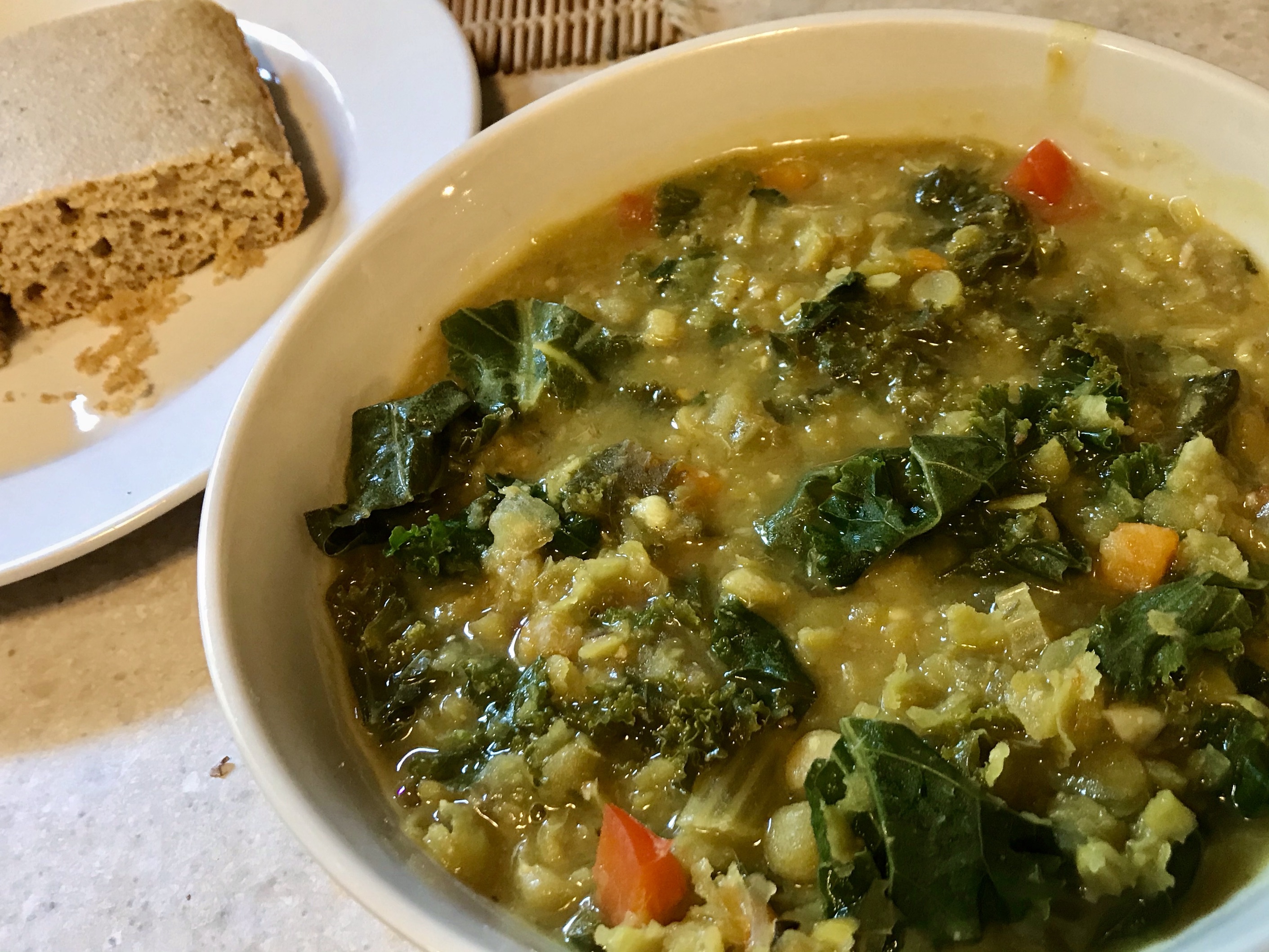
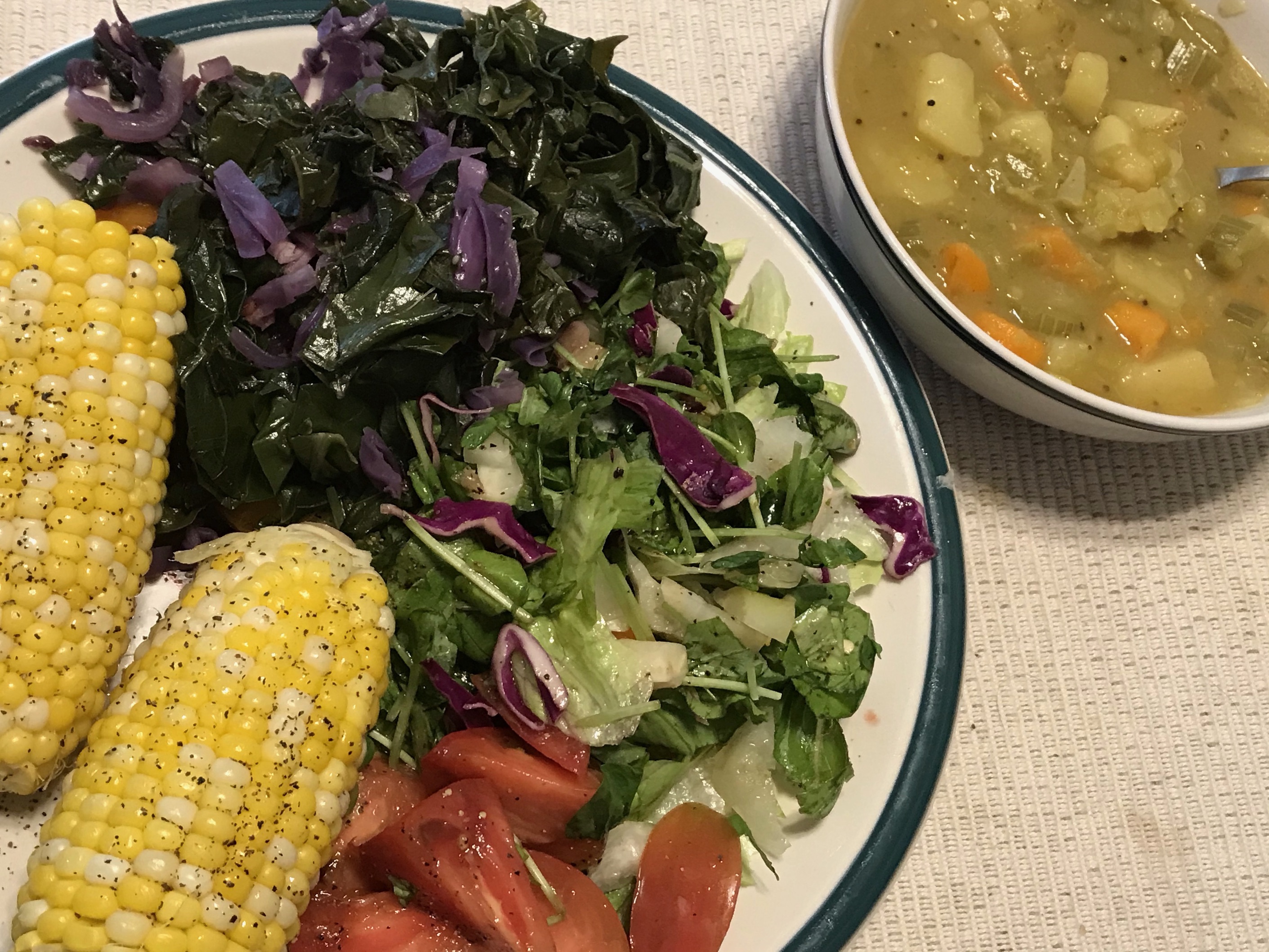
Steps
- Sort split peas and cover with at least double the volume of water to let it soak overnight. If not able to pre-soak, rinse peas.
- Heat a soup pot, and add oil. (See notes, below.)
- Add onion, celery, carrot, garlic, cumin seeds, ground cumin and curry or turmeric. Stir to coat veggies with the seasonings, and release the aromas. Cook, stirring 3-4 minutes, until vegetables begin to soften.
- Drain soaking water from peas, and add to pot with fresh water / broth to cover by 1-2 inches, or about 6 cups, give or take. Bring to a boil. Remove any foam with a spoon.
- Add kelp / kombu seaweed, bay leaves, and potatoes.
- Reduce heat to medium-low, and cook, covered, about 30 minutes. Add cucumber if using, and continue to simmer another 15-20 minutes, or until split peas have broken and are tender soft.
- Stir in kale or collards, if using; add pepper, and any other seasonings including a pinch of chili powder if you like a little spice, and/or add a bit of smoked or plain paprika, tamari, if using, and a few or more drops of liquid smoke ~ more if you like a smoky flavor. If using miso paste, skip the tamari. Let simmer a few more minutes, then turn off heat, but leave covered for another 1-2 minutes. Taste, and adjust seasonings as desired. The flavors meld more as it sits.
- If using miso, ladle into serving bowls, then stir in miso paste using the back of another spoon.
- Garnish as desired ~ with fresh diced or roasted red bell pepper, scallions, or fresh herbs.
- Adding a squeeze of lemon freshens the soup. I sometimes use a smidge of sherry. However, both are totally optional.
>>>For more vegan macrobiotic recipes, check out my FREE E-BOOK(S)
>>>Tips for Plant-Based Meal Prep >>>Best Brown Rice ~ Cooking, Reheating, Porridge, Sushi & More
